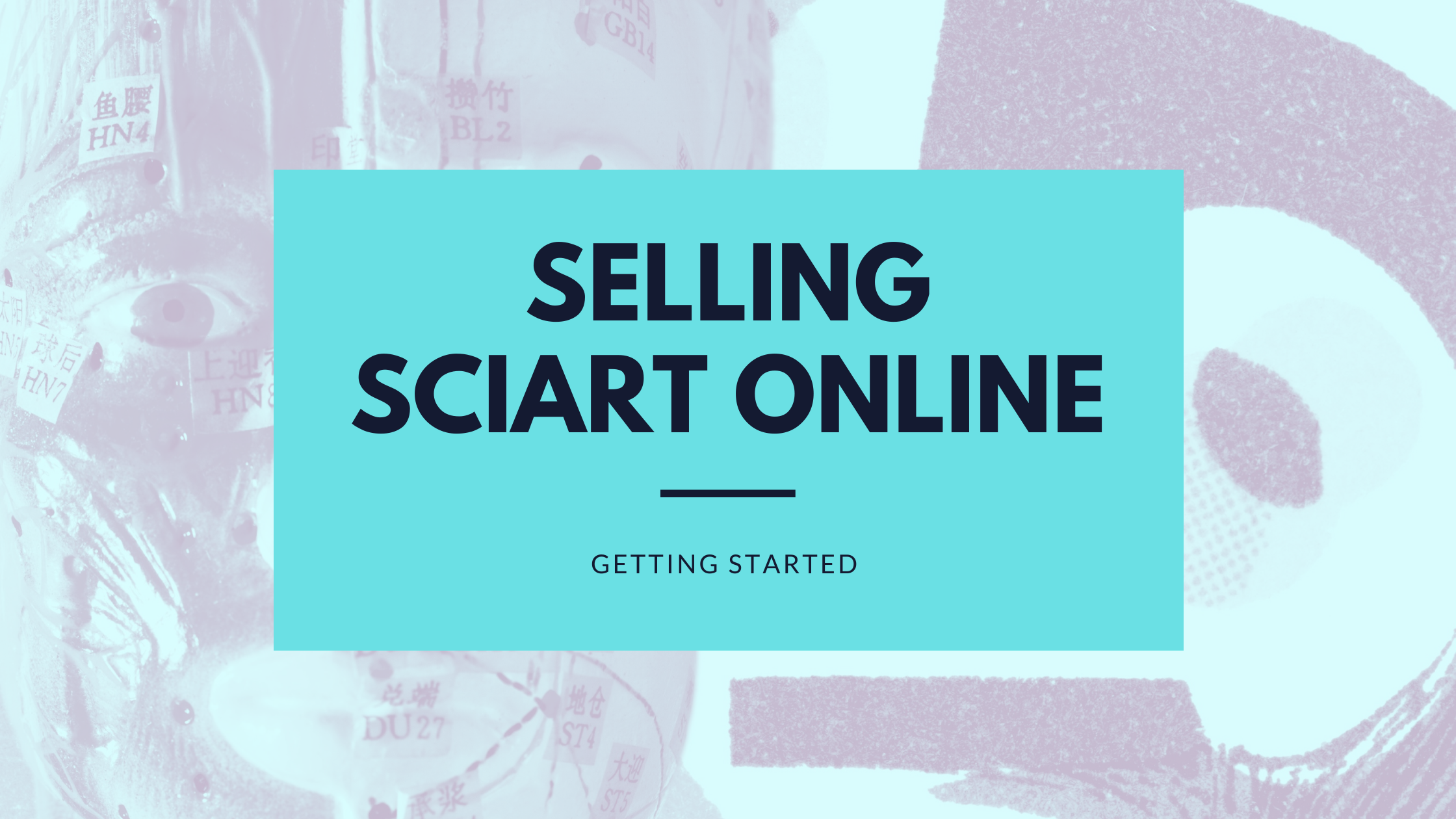
Do you want to sell SciArt online? …..Are you feeling overwhelmed? Don’t know where to start? In this blog post, we will look at the pros and cons of popular platforms, give an overview of what they offer, and some tips for getting started. What makes an effective online marketplace? Is it as easy as taking photos of your SciArt, uploading, setting up shop, and watching the money come rolling in?

Etsy
Enter the term SciArt into the search box in Etsy, and you will find a plethora of products: stickers, prints, t-shirts, crotchet patterns, jewelry, and phone cases.
“Etsy is really good if you have hand-made, colorful products to sell. It can also do well with stickers.” – Alejandra Enriquez
Advantages:
- Etsy was started over 14 years ago and currently sells over 60 million products. 5 million are art and collectable products.
- Etsy has a blog, forums, and many resources, including a seller handbook with a wide variety of topics to help you get started. You can learn about everything from photography how-tos, growth strategies, packaging, taxes, branding your shop, and much more.
- The Etsy platform has a targeted customer base. Uniqueness and quality sell well.
- Opening a shop on Etsy is free and quick.
- There is a great collaborative community at Etsy. You can learn a lot and even find a mentor!
- Etsy charges a listing fee of .20 USD for each item you list on sale on Etsy.com or the Etsy mobile app.
- You are charged a listing fee whether the item sells or not unless it is a private listing. The listing remains active for 4 months. Note: Etsy rates are subject to change at any time.
- When you make a sale through Etsy.com, you are charged a transaction fee of 5% of the price you display for each listing, plus the amount you charge for shipping and gift wrapping. The sale money is transferred to you immediately.
Disadvantages:
- 60 Million products – this means that competition is fierce. You cannot rely on setting up shop and waiting for traffic. You will need to network, promote, and share your work beyond Etsy. There is a lot of potential traffic. It would help if you did your homework to find out how to maximize potential and get noticed.
- You will need to make sure your margins are correct and account for listing and shipping costs when setting prices.
- Etsy has full control over your store, and this means they have the ability to shut it down immediately and without warning if they believe a rule is being violated.
Lifeology member Anna Doherty uses Etsy to sell illustrated cards and prints. Check out her store here!
Redbubble
Redbubble was born in 2006 in Australia. Their website states they put “uncommon designs on awesome stuff.” They are a print-on-demand business. Artists can open a shop, upload designs. Users then find designs they like and put them on an object they like.
“If you are planning on making bulk products, and want to do so for free, Redbubble is a good starting place. I will say that this site is more conducive to “modern” aesthetics, and you will only earn a certain amount for each item you sell due to the manufacturing fees. But if you want a free account with no potential for negative expenditures, Redbubble is the place to go.” – Alejandra Enriquez
Advantages:
- You get to choose and control your profit margin. There is a standard fee for each of Redbubble’s products. The seller then adds the commission they want to earn from each sale.
- Redbubble has many products on offer—over 60 products, from t-shirts to pillowcases.
- Sellers can upload illustrations, graphic designs and photos. All of these can be printed on all items sold. This can increase the chance of a sale.
- Opening a shop is free. You can also find tips on their blog.
- Once you have uploaded your art and designs. Redbubble arranges all the printing (on over 60 products) and shipping to almost anywhere.
Disadvantages:
- Lack of community.
- No notifications when a seller uploads something new.
- You can follow people, but this feature is similar to liking something on social media.
Lifeology member Raymond Nakamura aka RaymondsBrain has a Redbubble store – take a peek here!
Society 6
Society6 allows an artist or designer to sell their work online. They have an array of products, from t-shirts to phone cases. Artist’s designs can be put on these products. It is the customer who gets to choose which artwork they want on a product.
“Society6 is also similar to Redbubble, but with more variance on the type of art there.” – Alejandra Enriquez
Advantages:
- The artist gets to retain the rights to their art.
- Speedy store set up with no monetary investment. A PayPal account is needed.
- It is straightforward to use.
- Great way to experiment and practice marketing.
- It requires no work in terms of fulfilling orders. Society6 takes care of orders.
- Good quality products.
- Sellers are allowed unlimited image uploads.
- It’s good for making some additional spending money.
- Tagging and description fields are built into the platform. An artist will need to know their metadata.
- Helpful Seller’s Guide.
Disadvantages:
- It takes a while to see a payment.
- It isn’t easy to get established.
- Artists earn a tiny percentage of each sale.
- Sellers need to work at getting traffic to their shop.
Shopify
Shopify is a commerce platform that allows anyone to set up an online store and sell their products without coding knowledge.
“Shopify is polished, which means it is stable. It’s well-known and many high profile websites use it. It is expensive so you need to know what you’re doing from a business standpoint.” – Doryan Algarra
Advantages:
- Easy to use and maintain. No need for technical experience, but users have full access to code if needed.
- Good quality product with appealing store themes, or you can create your own.
- Built-in marketing tools and apps such as SEO, automation, discounts and selling on social media
- Cart function for abandoned carts.
- Able to sell digital goods.
Disadvantages:
- Limited free themes and paid themes can be expensive.
- The apps are not free. You will need to upgrade your plan to access these.
- Pricey for beginners or those without an established customer base.





